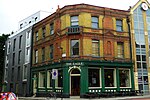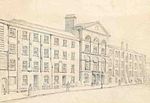Mount Pleasant Mail Centre
Buildings and structures in the London Borough of IslingtonGovernment buildings completed in 1889Infrastructure in LondonPost office buildings in the United KingdomRoyal Mail ... and 1 more
Sorting offices

The Mount Pleasant Mail Centre (often shortened as Mount Pleasant, known internally as the Mount and officially known as the London Central Mail Centre) is a mail centre operated by Royal Mail in London, England. The site has previously operated as one of the largest sorting offices in the world. It is located in the London Borough of Islington, on the boundary with the London Borough of Camden.
Excerpt from the Wikipedia article Mount Pleasant Mail Centre (License: CC BY-SA 3.0, Authors, Images).Mount Pleasant Mail Centre
Calthorpe Street, London Clerkenwell (London Borough of Islington)
Geographical coordinates (GPS) Address External links Nearby Places Show on map
Geographical coordinates (GPS)
| Latitude | Longitude |
|---|---|
| N 51.524722222222 ° | E -0.11194444444444 ° |
Address
London Central Mail Centre (Mount Pleasant Mail Centre)
Calthorpe Street
WC1X 9HX London, Clerkenwell (London Borough of Islington)
England, United Kingdom
Open on Google Maps










